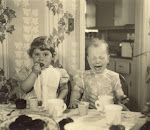Peggy, Ann, Patty, Dot, Kay, Billie
in the 1970s
“What do you call the paper thing you make a dress from?”
I would say, “It’s a pattern." (Pronounced pad-earn.)
Much laughter as they'd say, "It's a pattern." (Pronounced like General Patton's last name.)
Always glad to make people happy, I fell for it many times.
The problem here (Really no problem. I'd fall for it---they'd laugh.) is what linguists call rhoticity.
Not Rotisserie---Rhoticity
"English pronunciation can be divided into two main accent groups: A rhotic speaker pronounces the letter R in the word hard; a non-rhotic speaker does not pronounce it in the word hard…non-rhotic speakers pronounce R only if it is followed by a vowel sound."
There is no vowel after the R in pattern. Growing up in Ohio and then Kansas, I became a rhotic speaker. Apparently one learns one's accent between the ages of 8 and 14 from one's peers. Not from one's horrified mother who insisted there was no such thing as a "warsh rag."
These items are called warsh-rags in Cincinnati, Ohio
I don't know where the R in waRsh rag comes from.
It all must have have grated on my mother's nerves. She was a non-Rhotic speaker.
Cele, Bahbuhruh (or is it Jane?), Ben and Bill
Summer, 1959
She called me Bah-buh-ruh. No R until it's followed by a vowel at the end.
Worse, she called my close friend Linder Tayluh, adding an R to the end of Linda, an R she borrowed from the end of Taylor.
I can't imagine why I pronounce the double TT's in pattern like a D, but I tell you I'm not the only one out here. I'm in the quilt pattern business so it's a word we often use---apparently we all have accents out here on the plains.
P.S. Not only is there a Manhattan, Kansas, there is a Long Island, Kansas (not a drop of water in sight.)










No comments:
Post a Comment